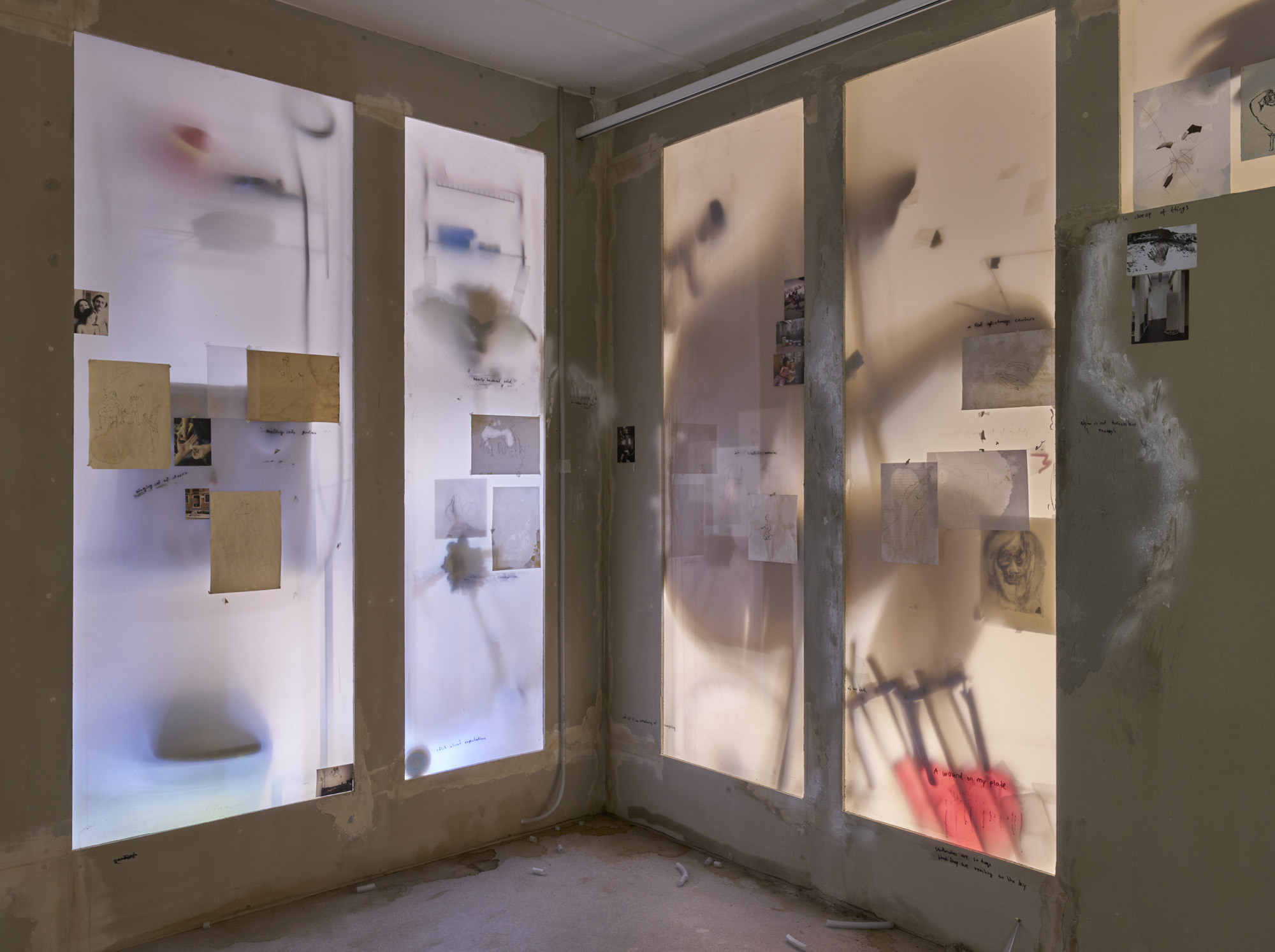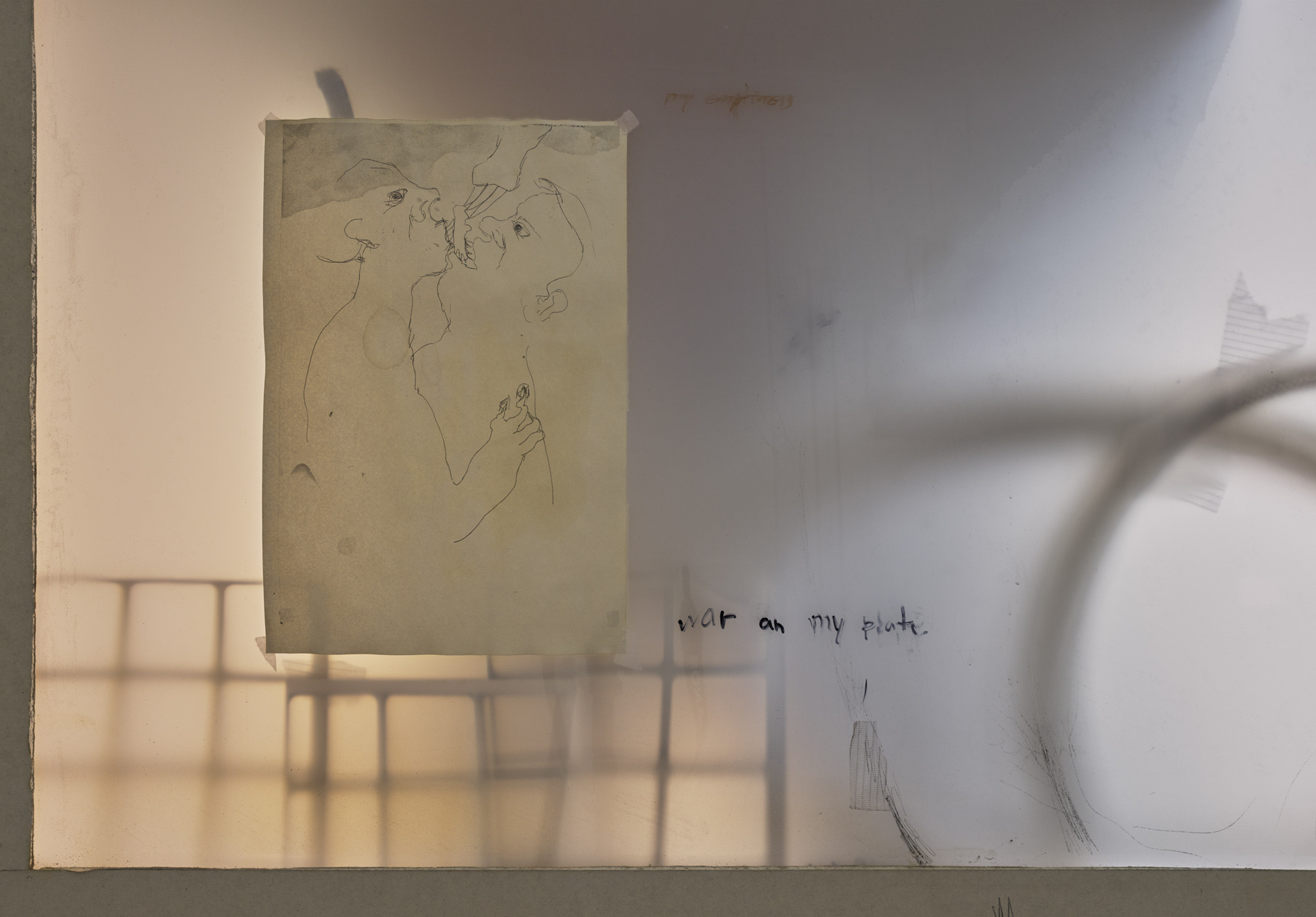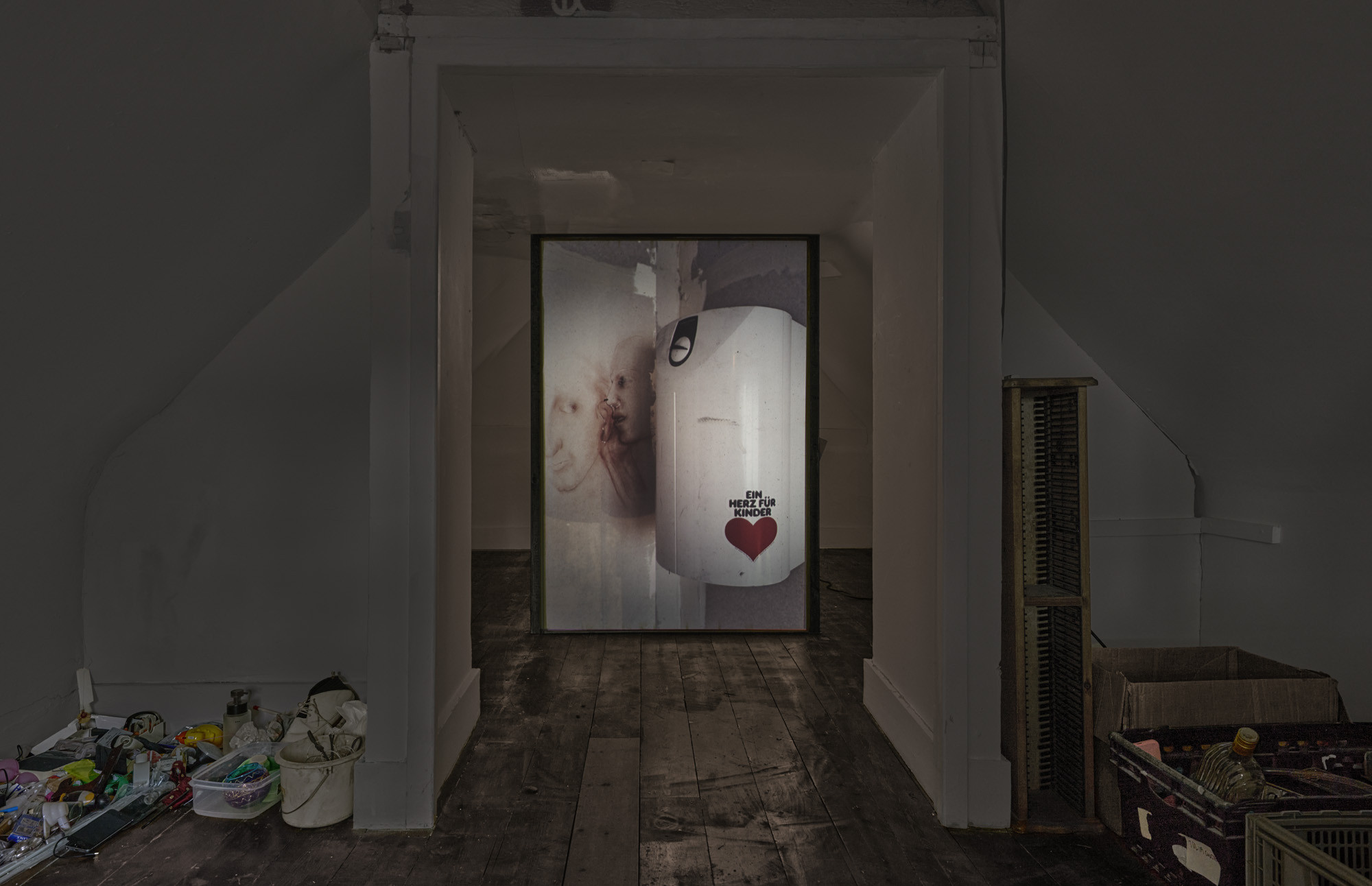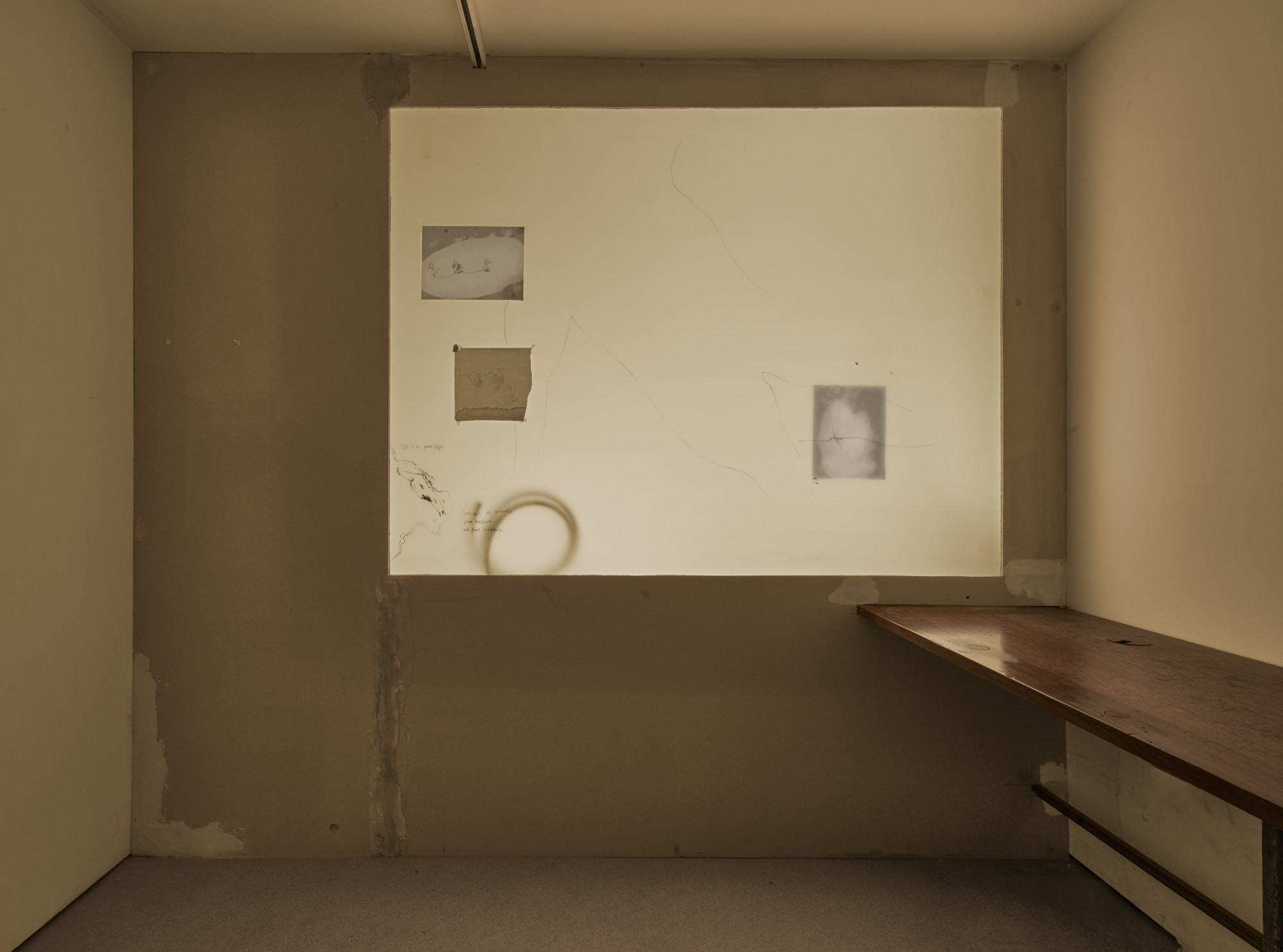
Emalin is pleased to present a wound on my plate, Tolia Astakhishvili’s (b. 1974, Tbilisi, GE) first solo exhibition in the United Kingdom. Through a month-long engagement with The Clerk’s House, the artist has reshaped the gallery through architectural interventions, sculpture, painting, drawing, sound and moving image. The resulting exhibition comprises a body of new works alongside collaborations with Zurab Astakhishvili (1951 – 2025, Tbilisi, GE), Dylan Peirce (b. 1977, Paris, FR) and James Richards (b. 1983, Cardiff, UK).
Astakhishvili’s practice unfolds as a series of nested interiors, collaged worlds within worlds where multiple registers intersect. In this simultaneity, architecture becomes a structural material, responsive and unfixed, rewritten by the bodies and histories that move through it. Her interventions uncover hidden recesses and interstices, mapping the subtle remnants of use and care, while exposing the authority of existing structures and how they may be reorganised, concealed or sacrificed. Running through this process, Astakhishvili demonstrates an attentiveness to the human impulse to make - and to discard. Domestic debris and disavowed objects, clutter estranged from its former use, are gathered and sorted into strange new arrangements. In her hands, these objects, alongside raw construction material, drawings, writings, trompe-l’oeil painting, photographic imagery and sound, coalesce into stratified forms that seem inhabited by residual life, as though memory and desire have inscribed themselves into matter. Her exhibitions emerge as a kind of psychic architecture. Interiors, thickened by projection and interpretation; recursive spaces, swollen beyond their own perimeter until their dimensions feel unstable. The exhibition's title, a wound on my plate, gathers this condition into an image, where what injures and what sustains appear together, arranged on the same surface. For the artist, the wound is symbolic just as much as it is insistently material: a lived condition, painful and embodied, inscribed in the fractured architectures, worn surfaces and provisional forms that organise her practice. Its challenge is to inhabit what is partial, broken, incomplete, and to find vulnerability within it – but renewal as well.
On the ground floor, plasterboard and plexiglass partitions absorb the gallery’s existing architecture and redraw its proportions, slotting into the 18th-century panelling to form luminous vitrines that evoke shop windows or sealed reliquaries. The surfaces of these partitions are stained with coffee and wood oil and marked by accumulations of scribbles, figurative drawings and handwritten fragments, so that the membrane of each vitrine reads as a palimpsest of incidental traces and memory. Lit from within, the resultant glow provides the only illumination, making the room itself seem staged by their presence. They hold fragments of colour, furniture and found objects as blurred silhouettes, pressed against the plexiglass. The contents seem both close and unreachable; depth collapses into surface, surface sinks back into depth. There is, always, the impression of something withheld, a life glimpsed only in outline. In this withholding, the vitrines become spaces of projection and interpretation, opening room for imagination. This encounter unfolds as a two-way reverie: one is drawn inward by the scene’s mysterious suggestion, only to be returned to the surface, to the tactile insistence of walls, objects and matter.
Upstairs, a plasterboard-and-mirror structure stands as an enigmatic insertion, an object that feels too large for the room that holds it. Open on one side, it reveals a sequence of layered apertures, some mirrored so that the view multiplies and folds back on itself. Looking in, one sees shifting reflections and partial openings, an interior that never seems to resolve. The form recalls the cupboard-like box beds common in medieval Europe, compact enclosures built inside larger rooms that offered warmth and seclusion while producing the sensation of a space bigger than its frame. The work's title, between the legs (2025), draws out these associations, naming a site of nearness: intimate, protective, enclosed. It also invokes desire, vulnerability; a psychic vastness imagined within the body. The work materialises this ambivalence, giving it proliferative spatial form: a structure that refigures interiority as inexhaustible generativity. The rhythm of the exhibition adheres to this logic: paths circle back, closures reopen, familiar scenes return altered, as if perception could only ever deliver the same moment transformed, multiplied and dreamlike. Such serial recursions also echo the artist’s broader approach to exhibitions, which often operate as multi-chapter constellations rather than singular events.
Nearby, a painted theatre backdrop, Delicate dump dusty all recently decorated (2025), depicts the cellar of the Cité Internationale des Arts in Paris, rendered in photorealistic detail from a photograph taken by the artist. A prop for the stage, it finds itself here miscast, performing outside its role. One interior is folded into another, holding the viewer between the material fact of paint and the pull of imagined space. Trompe-l’œil functions here as part of Astakhishvili’s larger project of turning structures into sites of projection, spaces where doubling confuses what might normally be read as a given and invites other kinds of inhabitation.
Throughout, Astakhishvili balances a sense of excess and fullness with great care. Pockets of negative space and unoccupied intervals interrupt the density of layered encounters, so that the entire house becomes part of the work’s choreography. This includes sound, which is profoundly transportive here, despite its discreetness, and works like a binding haptic force. Composed with long-time collaborator, Dylan Peirce, the ambient score of electric hums, barely audible currents and resonant tones seeps through the installation, lending the work a steady, bodily, continuity.
In her practice, Astakhishvili challenges notions of authorship and autonomy by incorporating works by other artists, family and friends directly into her installations. These ongoing collaborations open a polyphonic field where personal and geopolitical histories overlap without closure. In the ground-floor office, collages by the artist’s late father, Zurab Astakhishvili – a lung specialist and alpinist doctor – are spread across the walls. In I can’t imagine how can I die if I am so alive (1986–ongoing), faces of friends and family crowd together over magazine clippings and newsprint, humorous and irreverent yet formally deft, their lightness countering the gravity of the house itself. Where Zurab Astakhishvili’s collages operate through the density and accumulation of image, Astakhishvili’s collaboration with James Richards reworks the relation between image and space. In the attic, their slide projection From Communion to Cannibalism (2018–2025) brings together photographs of earlier installations cut against found images, medical diagrams and incidental fragments, producing a constellation of dislocations where past and present catch in loops of distortion.
Some works in the exhibition shift scales to the almost imperceptible. Positioned on windowsills on the first floor and in the attic, comprises a group of miniature sterling silver figures that fit within the hand. Cast in silver, a material bound to histories of value and exchange, the figures hold gestures that remain unresolved. They might be traveling, fleeing, working, embracing or fighting. At a moment when perception is increasingly shaped by machine vision and data networks that apprehend reality at scales far removed from the body, the work insists on the nearness of things, on gestures legible in their uncertainty and contingent upon closeness itself.
“I can’t tell if I’m remembering or composing,” reads a handwritten line on one of the vitrines. The phrase points to the fragile indistinction between memory and invention, and to the sadness that memory itself may be nothing more than an act of composition. a wound on my plate inhabits this unsettled register, where truth scatters into detail and resolution gives way to imagination – an opening toward the unrealised. It is an architecture of fracture and accumulation, that confronts the instability of perception, the afterlife of objects and the difficulties of inhabiting this world at all.
––
Tolia Astakhishvili (b. 1974, Tbilisi, GE) lives and works in Tbilisi, Georgia and Berlin, Germany. She graduated with a BFA from the Academy of Fine Arts in Tbilisi in 1994 and Johannes Gutenberg University, Mainz, in 1996, and completed the MFA at London’s Chelsea College of Art in 2001. Her recent solo exhibitions include to love and devour, curated by Hans Ulrich Obrist, Nicoletta Fiorucci Foundation, Venice, IT (2025); Result, LC Queisser, Tbilisi (2025); between father and mother, curated by Kyle Dancewicz, SculptureCenter, New York, US (2024); The First Finger (chapter II), curated by Beatrice Hilke, Haus am Waldsee, Berlin, DE (2023); The First Finger, curated by Fatima Hellberg, Bonner Kunstverein, DE (2023); and I Think It’s Closed, curated by Oriane Durand, Kunstverein Bielefelder, DE (2023). Her work has been included in group exhibitions at Foundation Pernod Ricard, Paris, FR (2025); MoMA PS1, New York, US (2025); MACRO Museum, Rome, IT; LC Queisser, Tbilisi, GE (2024); Emalin, London, UK (2024); Kunsthalle Zürich, CH (2023);Galerie Molitor, Berlin, DE (2023); Felix Gaudlitz, Vienna, AT (2022); Art Hub Copenhagen, DK (2021); Räume für Kunst, Kerpen, DE (2021); Bonner Kunstverein, DE (2021); Capitain Petzel, Berlin, DE (2021); and Malmö Konsthall, SE (2019)
Zurab Astakhishvili (1951 – 2025, Tbilisi, GE) was a medical doctor in Tbilisi, Georgia, specialising in respiratory medicine, and an experienced alpinist. In collaboration with his daughter Tolia Astakhishvili, he developed an artistic practice in his spare time, which became his permanent occupation.
Dylan Peirce (b. 1977, Paris, FR) is a multidisciplinary artist who works in the field of sound, experimental photography, sculpture, video and installation. He has been teaching sound and installation at the UdK Berlin since 2018. Selected exhibitions, performances and interventions have taken place at MoMA PS1, New York, US (2025); SculptureCenter, New York, US (2024); Bonner Kunstverein, Bonn, DE (2021); Rennes-Biennial for Contemporary Art, FR (2012); KW, Berlin, DE (2003); and Vleeshal, Middelburg, NL (2011). In 2022, he released his album Pindrops on the Berlin label Digital In Berlin.
James Richards (b. 1983, Cardiff, UK) lives and works in Berlin, Germany. His practice includes moving image, music and curatorial projects. Richards was shortlisted for the Turner Prize in 2014. In 2017, he represented Wales at the 57th Venice Biennale and was awarded the Preis der Nationalgalerie 2024. Forthcoming projects will be held at Sylvia Kouvali, London / Piraeus, UK/GR; Ordett Milan, IT; and Momuk Vienna, AT.






